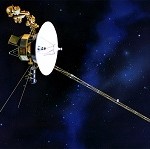A hearty “Well done!” to an old traveler – the US spacecraft Voyager 1: NASA has confirmed today, that the space probe has reached a point in the outer solar system where the effects of the solar wind are no longer measurable (it actually reached that point in June but the results got confirmed today).
At a current distance of unbelievable 10.8 billion miles from the sun, this makes her and her sister ship Voyager 2 the two man-made items that had gone farther and deeper into space than any other spacecraft or probe has ever done (and there is not much to suggest that they will have to share that title any time soon with any other space probe).
Distances
Speaking of distances, let’s bring things into perspective: in general, astronomy deals with huge distances and astronomers have come to use different measurements than miles or kilometers because the numbers grow far to large. Instead, astronomical distances are measured in really “astronomical” units (you will see: its a play of words):
- The Earth is about 150 Million Kilometers away from the Sun – in numbers: 150.000.000 Km. To make it easy, astronomers have called this an Astronomical Unit. So if someone says “This spacecraft has traveled 1 Astronomical Unit” then this means “This spacecraft has traveled a distance of 150 Million Kilometers.“
- The light of the sun needs to travel roughly 5 Astronomical Units – in other words: about 750 Million Kilometers – until it reaches the larges planet in our solar system: Jupiter. For that distance, the light will need about 45 Minutes…
- In order to reach Pluto, the light of the sun would have to travel almost 40 Astronomical Units – in numbers: almost 6.000.000.000 (6 Billion!) Kilometers. That is so far, it would take the light about 5.5 hours to get there (and there is nothing faster than light, as far as we know!).
And that is where our solar system ends for many of us (even though we know today there are dwarf planets behind Pluto). Voyager 1 has gone way beyond that: tonight, she is an unbelievable 115 Astronomical Units away from Sun (or Earth, at that distance, it does not matter).
115 Astronomical Units – that is 17.250.000.000 Km or roughly 10 billion miles. The light of the Sun needs 16 hours to get there – and so does any radio control signal the NASA is still sending to the space probe.
And what is next? In another few years (maybe as little as four) the probe will leave the Solar System and enter interstellar space – it will be the final frontier to cross and Voyager 1 will be the first space probe launched by man to go where nothing man-made has ever gone before….
Reflections
Voyager 1 has also left us something else to consider – and I wish, people would really reflect on it: in 1990, the space probe took a last set of photos looking back at where it has come from. From a record distance of 6 billion kilometers, it photographed Earth – nothing but a “pale blue dot” almost invisible in the vastness of space.
Usually, I write my texts myself – there is no point in being a copy-cat or thief of other people’s words – but in honor of Carl Sagan, I would like to quote a great assessment he made on that particular photo:
“From this distant vantage point, the Earth might not seem of particular interest. But for us, it’s different. Look again at that dot. That’s here, that’s home, that’s us. On it everyone you love, everyone you know, everyone you ever heard of, every human being who ever was, lived out their lives. The aggregate of our joy and suffering, thousands of confident religions, ideologies, and economic doctrines, every hunter and forager, every hero and coward, every creator and destroyer of civilization, every king and peasant, every young couple in love, every mother and father, hopeful child, inventor and explorer, every teacher of morals, every corrupt politician, every “superstar,” every “supreme leader,” every saint and sinner in the history of our species lived there – on a mote of dust suspended in a sunbeam.
The Earth is a very small stage in a vast cosmic arena. Think of the rivers of blood spilled by all those generals and emperors so that, in glory and triumph, they could become the momentary masters of a fraction of a dot. Think of the endless cruelties visited by the inhabitants of one corner of this pixel on the scarcely distinguishable inhabitants of some other corner, how frequent their misunderstandings, how eager they are to kill one another, how fervent their hatreds.
Our posturings, our imagined self-importance, the delusion that we have some privileged position in the Universe, are challenged by this point of pale light. Our planet is a lonely speck in the great enveloping cosmic dark. In our obscurity, in all this vastness, there is no hint that help will come from elsewhere to save us from ourselves.
The Earth is the only world known so far to harbor life. There is nowhere else, at least in the near future, to which our species could migrate. Visit, yes. Settle, not yet. Like it or not, for the moment the Earth is where we make our stand.
It has been said that astronomy is a humbling and character-building experience. There is perhaps no better demonstration of the folly of human conceits than this distant image of our tiny world. To me, it underscores our responsibility to deal more kindly with one another, and to preserve and cherish the pale blue dot, the only home we’ve ever known.”
Carl Sagan, “Pale Blue Dot”
There is nothing more to say…

